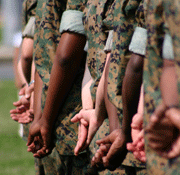
Oct/Nov 2006
SNAPSHOTS OF DISCIPLESHIP
|

|
disciples in uniform
SERVING AMERICA'S FIGHTING CONGREGATION
by Richard Anderson
To learn more about Free Will Baptist Home Missions and Free Will Baptist chaplains, visit www.homemisions.net. |
ONE OF THE GREAT DOCTRINES of Christian orthodoxy is the incarnation, a word derived from the Latin in and car meaning “in flesh.” The incarnation refers to the act whereby the eternal Son of God, the second person of the Holy Trinity, took upon Himself human nature through the virgin birth.
The Apostle John refers to Jesus becoming flesh in the opening chapter of his gospel. John 1:14 states, “And the Word was made flesh, and dwelt among us, (and we beheld his glory, the glory as of the only begotten of the Father,) full of grace and truth.” The word rendered “dwelt” translates the Greek word, eskenosen, from skene, which means “tent” or “tabernacle.” Three great truths emerge from the use of eskenosen.
First, just as God lived with Moses and the Children of Israel in the Old Testament tabernacle, so now He dwells with us through the incarnation (i.e. the human nature) of Jesus Christ. Second, eskenosen denotes that Jesus’ life on earth was not intended to be permanent, for He lived here as in a “tent.” Third, like a soldier, Jesus’ state on earth was a military one. Soldiers, often find themselves dwelling in tents, especially during a war. Jesus Christ, having declared war with “the seed of the serpent,” positions Himself in the field, pitches His tent, and carries out the ultimate global war on terror.
In other words, the history of the chaplaincy of the
United States military reaches back to the beginnings
of the nation itself.
The depiction of Jesus through the use of eskenosen serves also as a beautiful portrait of the military chaplain living among those he has been called to serve. The word “chaplain” predates medieval Europe, and it is commonly linked to St. Martin of Tours, a fourth century Hungarian Bishop. The actual concept of the military chaplain arrived on the continent of North America during the seventeenth century. However, the employment of military chaplains was not authorized until July 19, 1775, when the Second Continental Congress sanctioned the use of chaplains during the American Revolution upon the recommendation of General George Washington. In other words, the history of the chaplaincy of the United States military reaches back to the beginnings of the nation itself.
Since that time, military chaplains have made significant contributions to America’s fighting congregation by providing moral leadership and spiritual guidance to generations of soldiers and their families in both peace and war. Fleet Admiral, Chester W. Nimitz (1885-1966) was Commander in Chief of Pacific Forces for the United States and Allied Forces during World War II. At the height of the war, he commanded more than two million men and women, along with 5,000 ships and 20,000 planes. Recollecting his days of command, he stated, “By patient, sympathetic labors with the crew, day in, day out, and through many a night, every chaplain I know contributed immeasurably to the moral courage of our fighting men...Most of it was necessarily secret between pastor and confidant. It is for that toil, in the cause both of God and country, that I honor the chaplain most.”
In subsequent issues of ONE Magazine, I will attempt to explain the intricate nature of ministry within the military as I seek to honor those who serve America’s fighting congregation.

Richard Anderson serves as a Chaplain in the United States Air Force. Currently, Chaplain Anderson is the Senior Protestant Chaplain, Lajes Field, Azores, Portugal. He holds a B.S. in Bible and Secondary Education, a M.Div. with Biblical Languages (Hebrew and Greek), and a Ph.D. in Religious Studies. He is married to Faith (VanWinkle) Anderson, and they have two sons, Jack and Jonathan Wesley.
|
|

